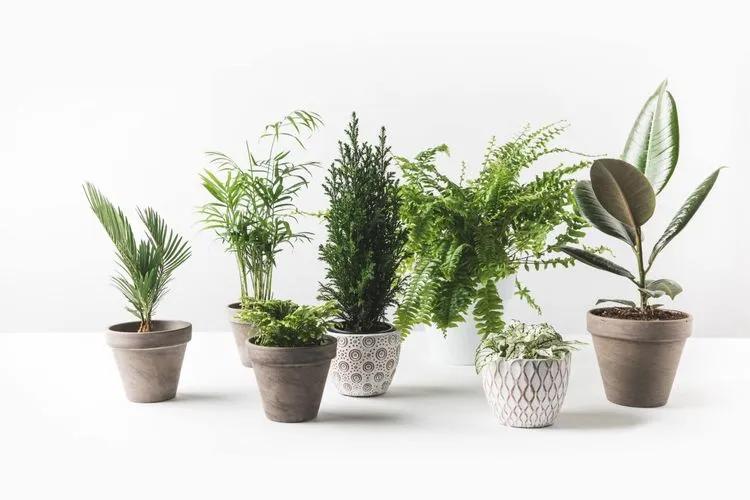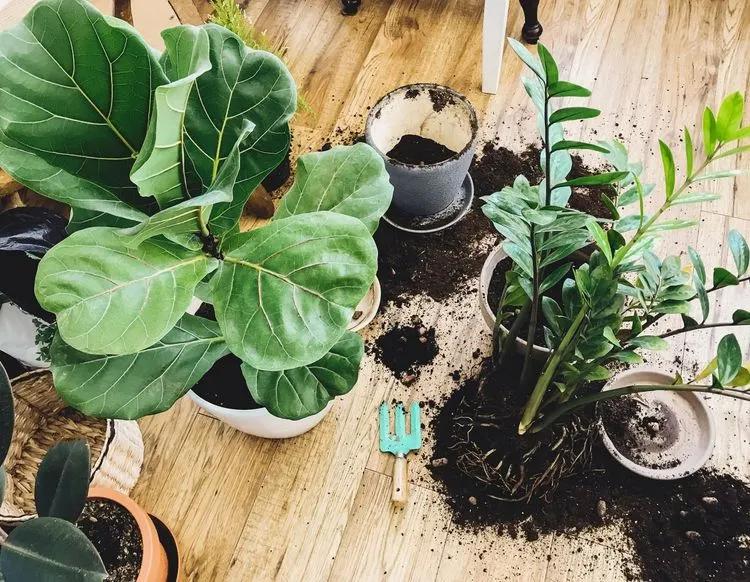 Indoor plants are a graceful interior decoration. They can be natural or faux. Whatever option you choose, potted plants will bring a sense of warmth, calmness, and coziness to any space.
Indoor plants are a graceful interior decoration. They can be natural or faux. Whatever option you choose, potted plants will bring a sense of warmth, calmness, and coziness to any space.
Nothing transforms an interior like potted plants! Nowadays, many people choose nature over art and real plants over artificial ones. There are a lot of advantages of decorating the space with real plants, for example, health benefits. At the same time, silk, velvet, or cellulose substitutes do not need any care. Modern, high-quality artificial analogs are not worse than real houseplants, so they make an excellent alternative for those with little time or experience in planting.
Herbs will make a great addition to any space, no matter if you prefer real flowers or artificial alternatives. They can solve many problems and improve the overall interior design. Houseplants can be used for:
- creating a pleasant green atmosphere in the house;
- zoning and visual increase of space;
- highlighting the advantages and hiding some of the shortcomings of the room.
Correctly selected plants bring a real zest to the interior. Thus, there is no unambiguous answer to which option is better - it depends on multiple factors, such as the space you plan to use and even your lifestyle. Stay tuned to learn all the pros and cons of real and faux plants to make your choice easier.
Advantages of real indoor plants
The benefits of fresh flowers are apparent. First of all, these are natural, pleasant aromas that evoke positive emotions and improve the overall atmosphere of the space. Including indoor potted plants or even a natural living green wall will provide many health benefits, both physical and emotional. Also, this option is advantageous in terms of ecology: living plants won’t result in wastes as they will decompose back into the environment. What is more, the appearance of the plant changes: they grow; unhealthy leaves can be pruned, and some plants can even be cut or braided in different shapes. Real plants purify the air and enrich it with oxygen. Unlike faux substitutes, they saturate life with new and changing beauty.
Disadvantages of real indoor plants
 Any natural plant is adorable, but these guys also have several flaws. Indoor flowers in pots die over time - especially when not treated right. They can become unhealthy or be pest-infested. In this case, they can emit unpleasant odors. Also, some flowers’ natural smell can be not enjoyable for humans or be too strong and even cause allergies.
Any natural plant is adorable, but these guys also have several flaws. Indoor flowers in pots die over time - especially when not treated right. They can become unhealthy or be pest-infested. In this case, they can emit unpleasant odors. Also, some flowers’ natural smell can be not enjoyable for humans or be too strong and even cause allergies.
The most important aspect is that real plants require constant care and the creation of a special microclimate. They need regular maintenance such as watering, fertilizing, and pruning. Sometimes life is too busy, and you can lose your green friends due to a lack of time for proper care. Real plants are good for interior design and your physical and mental health, but they require time, money, and special care.
Advantages of faux plants
The natural flora is extremely diverse in terms of plant species. However, modern technologies allow us to copy any plant - even the most exotic and unusual ones. Manufacturers have learned to repeat the smallest details (dots, veins, wormholes, shade transitions, and other elements) typical for real herbs. Hiqh-quality faux plants can look exactly like the real ones. Thanks to advanced technology, artificial flowers perfectly imitate their real counterparts and sometimes look even more beautiful.
Artificial plants can serve for many years, practically not needing care. They are built to last, so you won't need to replace them often. And you can easily move them from room to room in your home without having to worry about spilling dirt or leaking water.
Disadvantages of faux plants
 However, faux plants also possess a number of drawbacks. They do not emit a pleasant smell, and they are deprived of a natural texture. Choosing high-quality plant substitutes might cost an arm and a leg, while cheaper alternatives are often not so good-looking.
However, faux plants also possess a number of drawbacks. They do not emit a pleasant smell, and they are deprived of a natural texture. Choosing high-quality plant substitutes might cost an arm and a leg, while cheaper alternatives are often not so good-looking.
While fake plants can look real, they certainly don’t do their part for our indoor environment. In fact, they can be detrimental to our health as well as ecology. Fake plants are made using artificial materials and dyes, so they can make the air even worse instead of cleaning it. Second-rate materials smell, cause allergies, and pollute the environment. However, they still do not require your time, money, and special care.
Final thoughts
Make your choice based on your living conditions, priorities, and lifestyle. Factors you may consider are budget, available light, interior design, free time, state of your health, and planting skills. If you want to create a pleasant aesthetic atmosphere and improve the air quality in your house, living plants will make a perfect choice. However, do not forget that caring for them will take time.
If you are a busy bee, wanderer, or just not a green thumb, feel free to replace real plants with artificial alternatives. High-quality faux options look natural and will make a perfect addition to your space. You can consider purchasing the whole plant compositions from artificial materials and even large trees. Caring for them is reduced to periodic wiping.
And finally, no matter if you use natural or artificial plants when the space is organized properly. Arrange the plants following your taste and the stylistic direction of the interior, and your home or office will turn into a real green paradise!
